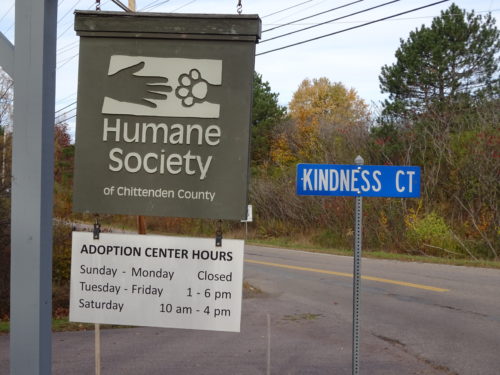Good News for Shelter Animals

Abby Gale from Long Trail Rescue
In 2013, when we were ready to adopt a dog, we headed for the local humane society. Our previous two dogs had come from there, but the kennels were practically empty. We tried a couple more times, but there was only a handful of dogs, and none was the right fit. Life intervened, the way it will, and we put the adoption on hold for a while.
Over a year later, on a friend’s advice we checked out Long Trail Canine Rescue, a small group in Vermont that worked with a humane society in Darlington, South Carolina, to relieve the overcrowding there and find dogs good homes here. After looking at the dogs on their website, we zeroed in on a mid-sized mutt. Our new dog arrived on one of the coldest nights of a deeply cold winter. I mean cold: It was already five below early in the evening. We drove through fresh snow to a house out in the woods, where two dogs were being dropped off after a two-day trip, including a sleepover in Delaware: one was a boisterous dog, who was going to a foster home, and the other was shivery, timid Zola, who was coming home with us.
In the early days, we took her to a dog park where, naturally, conversations started with complaints about the weather and then turned to our dogs. As soon as I said that Zola was a rescue dog from South Carolina, other people told me stories about their rescue dogs from states like Texas, Mississippi, Tennessee, and Georgia. Thus began a strictly unscientific survey over that winter and spring. Results? It appeared that the majority of the dogs at the park had been rescued from faraway places.

A dog from All Breed Rescue
My impression wasn’t false. Given the popularity of all kinds of breeds and mixed breeds, most dogs around here are not rescues, but people are now far more likely to adopt animals—and not just dogs—from shelters and through rescue organizations like Long Trail that relocate animals from areas with over-crowded shelters to areas where there is a higher demand for adoptable pets. For this and a range of other reasons, the fates of shelter animals all over the country—dogs, cats, rabbits, and others—have dramatically improved.
In the early 1970s, some 13.5-plus million animals were euthanized each year in the United States. Each year. If a dog, cat, or other animal went into a shelter then—or even as recently as ten years ago—its chances of coming back out were slim. This was especially true in big cities. For animal lovers, that’s a horrifying number. For the shelter workers who had to put all those animals down, that’s an excruciating number.
This has changed. According to a September 3rd article in the New York Times, euthanasia rates in big city shelters have dropped more than 75% over the last ten years. The Times collected information from the 20 largest cities and found that all municipal shelters had made remarkable progress between 2012 and 2018. In Texas, for example, Dallas reduced the euthanasia rates for dogs and cats from 65% to 19%, and Houston brought rates down from 57% to 15%. In the northern Midwest, Detroit went from a disheartening high of 86% to 31%, and Chicago dropped from 40% to 7%. Many major cities had already made progress before 2012. Still, their rates have dropped still lower (Austin is all the way down to 2%; San Diego to 7%; Seattle and New York to 8%). Instead of being euthanized, these cats and dogs (and other kinds of animals) have either been reunited with their owners or adopted into new homes.
The national numbers are still painfully high—nearly two million animals are euthanized each year—but the difference is stark. Remember, too, that many animals end up in shelters because they’re sick or injured.

A cat from the Humane Society of Chittenden County
Why and how did this happen? A number of cultural and organizational changes have taken place. Most important, urban shelters have become more professional and innovative. Their missions have shifted, and the ways they work have grown far more sophisticated. The Times article explains this well.
Other factors have contributed to these changes, as well. The no-kill shelter movement—which challenges shelters to commit not to kill animals who are healthy or can be treated, unless they’re dangerous, and to treat all animals with compassion—has gained momentum across the country. Increasingly, shelters form partnerships across regions to support one another, relieving overcrowding. And a large grassroots network, inconceivable before the internet, of rescue organizations like Long Trail, run by and large by volunteers, finds homes for animals in distant places. In our area several groups are at work: All Breed Rescue, Potter’s Angels Rescue, and VT Dog Rescue, to name three. (Some, like All Breed Rescue, even run their own shelters.) When you add breed-specific rescue groups, like Golden Huggs or Northern Greyhound Adoptions, the number grows.
As larger animal welfare organizations, such as the American Society for the Prevention of Cruelty to Animals, have also gotten involved in animal relocations, the number of rescued animals has soared. In 2014, the ASPCA helped relocate 529 animals, while in 2018, the number rose to 40,314. Overall, these changes signal that we as a society take the fates of animals far more seriously than we once did.
Organizations like the ASPCA and the Humane Society of the United States have also changed, though their core missions of promoting animal welfare remain. They don’t only care for animals, but care for the people who care for animals. They’re not just the animal cops, but have become community organizers, as well. This makes them more proactive. They serve people and partner creatively with the communities they serve. Not surprisingly, this improves the welfare of animals—and keeps them in homes and out of shelters.
These organizations now assume that everyone should have the chance to own and love a pet, with all the emotional and health benefits animals bring, and that everyone wants to care for their animals in the best way they can. But there are barriers. Keeping Pets for Life, a program run by the HSUS, defines its mission as “honoring the love people have for their pets, closing the service gap that exists for people and pets in underserved areas and bringing awareness in a new way to larger systemic inequities and injustices.” They offer services in areas where there are no veterinarians, providing free veterinary care, vaccinations, spay-neutering, and dog training—and sometimes turn these services into neighborhood events.
But what about smaller organizations in smaller cities and towns? Our veterinarian has helped run low-cost rabies vaccination clinics for our local shelter, the Humane Society of Chittenden County, for years. I was curious about what else HSCC is doing.

Their mission has also shifted: While they take in and find new homes for relinquished pets (974 adoptions in 2018), like other no-kill shelters, they also stress helping people keep their animals, what is called “surrender prevention.” The Director of Volunteer and Community Outreach, Erin Alamed explains that they “are creatively and actively trying to grow” all these programs.
HSCC is a pretty small organization serving a county of roughly 165,000 people. They make good use of the resources they have. In addition to the rabies clinics, they have a rainy day fund, which helps with one-time emergency veterinary care for those who can’t afford it. They help people find low-cost spay-neuter services through state and local organizations. And they offer one-on-one home visits from a dog trainer to help owners address particular problem behaviors—and keep their dogs.
They have also created a distinctive service in partnership with local human service agencies, the Good Neighbor Program, for individuals or families in crisis or transition who have lost housing and need to find a place for their pet. The HSCC takes in the animal—providing temporary shelter, food, vet care, and TLC—and keeps it confidential. (Mirroring this small local effort on a vast scale, a law has been passed in California, A.B. 415, which is scheduled to go into effect on January 1, 2020, to provide similar support statewide to victims of domestic violence based on evidence that some people delay leaving dangerous situations because they can’t bring their pets and won’t leave them behind for fear of what might happen.)
The HSCC programs are small because, of course, they don’t have enough resources. When we donate, we’re not just defraying the costs of keeping animals in a shelter, we’re supporting these kinds of efforts, as well.
Helping a family keep their cat or dog may seem frivolous in the face of other pressing social needs.But Keeping Pets for Life, the Good Neighbor Program, and A.B. 415 in California reveal how deeply animals are woven into our lives. Hurricane Katrina taught us—more importantly, it taught FEMA—that people feel that their pets are part of the family. Many people didn’t evacuate from New Orleans because they weren’t allowed to bring their pets on the buses. This particularly affected poorer people and older people, many of whom lived alone except for a beloved animal. FEMA changed the policy.
HSCC has started other innovative programs, too. All shelters end up with unadoptable cats—cats who pee all over the house, are feral or semi-feral, or won’t live indoors. In the past these cats wouldn’t find homes and were eventually euthanized. The HSCC has started the Barn Cat Program, seeking cat lovers with barns, stables, and other kinds of buildings where a cat can safely live (even through our sub-zero winters). They also run a trap-neuter-return program to reduce the numbers of feral cats in the community and to protect wildlife.
Finally, they have formed partnerships with a handful of other humane societies and accept transports of cats and dogs when those shelters are overcrowded and there’s room here. In the fall of 2018, after Hurricane Florence hit North Carolina and caused widespread flooding, they took in 30 cats and some dogs from a shelter in that area.
Take all these innovations and multiply them, certainly by the hundreds and maybe by the thousands all across the country, and you’ve got great news for shelter animals. And not just for them.

Though the snow and the cold were unfamiliar, our new dog adapted pretty darned fast.
References (in the order of their first appearance):
Alicia Parlapiano. “Why Euthanasia Rates at Animal Shelters Have Plummeted.” New York
Times, Sept. 3, 2019.
“Keeping Pets for Life.” Humane Society of the United States. Humanesociety.org.
